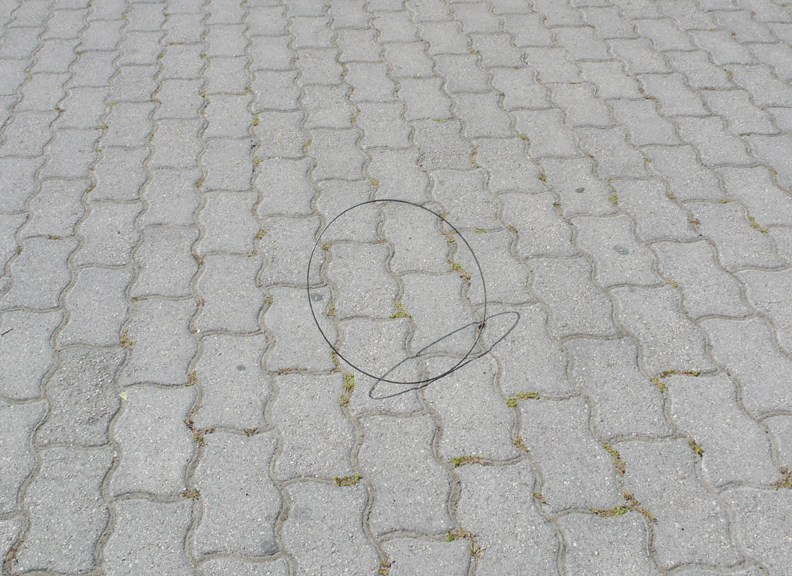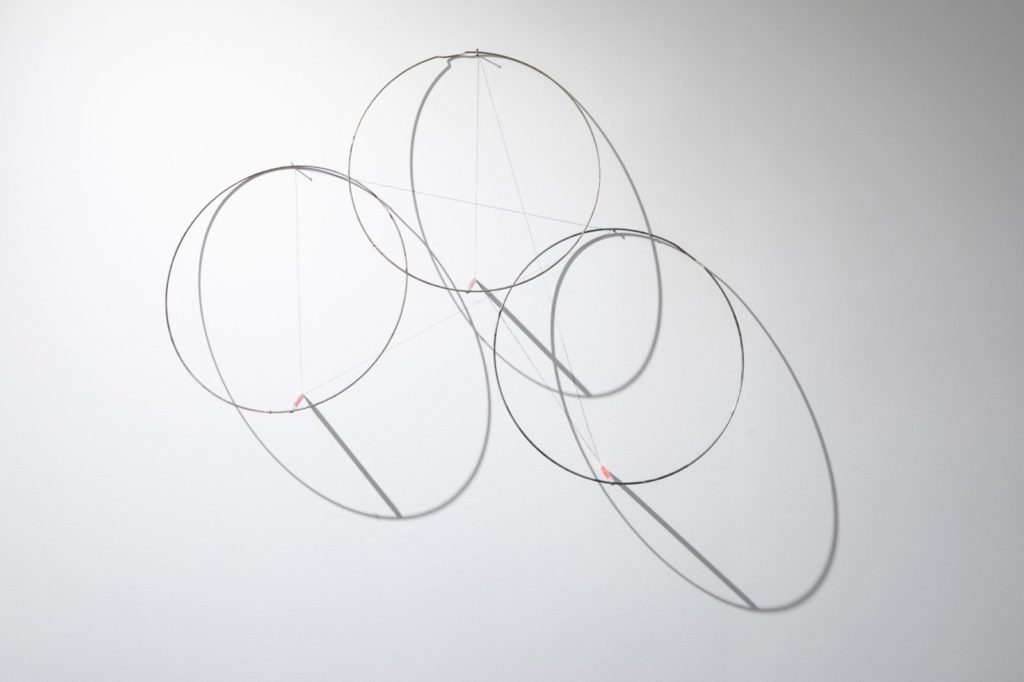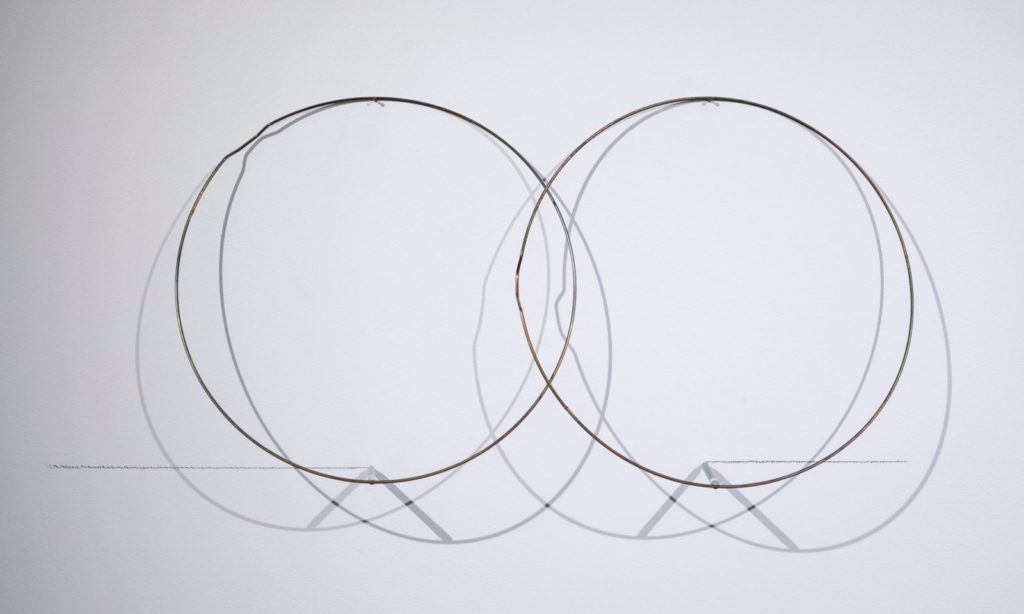Returning Full Circle

Reflections on the exhibition “There is no such thing as a perfect circle” by Felipe Dulzaides
“Draw a line everyday,” exclaimed 500 Capp Street Foundation board member Jane Reed. She brought this to our attention as an exercise of creativity in our artistic practice during recent shelter in place orders due to COVID-19. A simple and fundamental practice in making, each line becomes a subtle variation of the last. Some start and stop sooner than others, much like the unforeseeable future in our current pandemic, but each has a beginning and an end. Amongst the lines and forms taking shape as we traverse these unclear terrains, the linearity of time and our sense of place begins to become muddled. Ultimately, we will reach a point beyond our present dilemmas where things are relative to where they were prior, post pandemic. A prolonged pause with the promise of returning to a wholeness now too far gone perhaps a circling back, if you will.
Circularity is a common theme in Felipe Dulzaides’s work. Central to his practice is the realm of possibilities that the circle symbolizes and embodies. Particularly evident in his series Full Circle. Each of the three pieces exhibited in There is no such thing as a perfect circle has a varying number of metal rings creating a unique shape that overlaps and intersects, which makes light a key component in his work. Using four elements to create each piece, graphite, nail, pencil, and metal rings, the linear process traces are evident in the graphite lines and shapes made on the wall. The metal rings balanced on pencils cast distorted shadows, furthering this abstraction. Using found, circular forms and utilitarian objects to produce these fragile works, Dulzaides constructs these intimate pieces that capture various moments within the artist’s life. The circles are not solely a representation of the artist. Rather, these works contain the prospect of the self.
After defecting from Cuba to Rome in 1991, Dulzaides returned on a class trip in 1999 while enrolled at the San Francisco Art Institute. This trip was instrumental and acted as a catalyst for Dulzaides’ future artistic practice. Dulzaides is keenly aware of his multitudes, made evident when he first began attending SFAI. His experience was all too common. As a result of being an immigrant whose first language is not English and without a traditional background or base understanding of conceptual art, he did not speak up in class.1 However, Dulzaides continued to pursue his interests, pushing and experimenting within his art practice with encouragement from his professors and peers including fellow artists Tony Labatt, Paul Kos, and David Ireland. This duality inspired Dulzaides to experiment by turning the camera towards himself and framing his experience by using the language of metaphor, which is the ethos of his art practice. About twenty years later after his initial defection in 1991, Dulzaides returned to Rome for a year-long residency at the American Academy and was the recipient of a Rome Prize. This experience allowed Dulzaides to revisit locations that served then as a backdrop for his life-changing experience and resulted in work created for the aptly titled Full Circle series.2 After finding repeated circular forms originating from the retention wires of detached hubcaps of cars across the city, Dulzaides began playing around with these objects, relating them to light, balance, and place.

Dulzaides’s Full Circle series invites the viewer to imagine the artist’s narrative of return within and around the circular forms. The series acts as a group of geometric vessels subjected to further interpretation when understood as an intimate portrayal of the poignant crossroads faced in Dulzaides’s life and journey. Communicating through the abstraction of the circular form, Dulzaides departs from linguistic boundaries, highlighting the universality of simple geometric figures. As minimal ready-mades, his work emphasizes the importance of space, seen in the dimensionality of the pieces. The pencils leave traces as lines on the wall and create a space between that the work relies to retain a delicate balance and create various interconnecting shadows. This gap separates the work from being passive and flat on the wall to active, suggesting space beyond the wall. This depth allows the shadows to extend beyond their fixed size dependent on the light source. These artworks are delicate as are the images cast upon the wall.

In Splits End, two metal circles are positioned in the shape of a symmetrical Venn diagram. However, the two pencil lines drawn on the wall leading up to the pencils are disproportionate. Slightly shifting the sense of symmetry in the piece, Dulzaides creates a split between the two sides. This dual nature replicates the back and forth Dulzaides experiences between Cuba and the United States. Ni de aquí, ni de allá refers to the notion of being from neither here nor there and existing within those intersections while expanding the potential beyond the two.3 The use of fragile materials combined with the action of equilibrium underscore the tension of existing within these multiple identities; a navigating of the thin line between, like a trapeze artist.
As the exhibition title There is no such thing as a perfect circle suggests and acknowledges, the pursuit of perfection is a flawed endeavor in and outside of geometric shapes. For instance, the return-to or the circling back is a precarious predicament that recognizes the deviation from and the point of return in the present moment. Felipe Dulzaides understands his return to these sites throughout his career, be it Cuba, Rome, or San Francisco, comes with reconciling the evanescent nature of these places. How can one return to something that is no longer there or no longer the same? This moment is where we are now. This departure from our past-present within this interim quarantine of sorts is the deviation, a circling back. Now, as far as where that is or what that looks like is far beyond me. Until we return I’ll keep sketching lines, circles, and other forms until I can place myself within these ever shifting times.
- SFAIofficial, director. Felipe Dulzaides: Selected Works 1999-2013. Https://Vimeo.com/Sanfranciscoartinstitute, 26 June 2020, vimeo.com/76574136. [↩]
- SFAIofficial, director. Felipe Dulzaides: Selected Works 1999-2013. Https://Vimeo.com/Sanfranciscoartinstitute, 26 June 2020, vimeo.com/76574136. [↩]
- The concept of ‘Ni de aquí, ni de allá’ appears in Borderlands/La Frontera: The New Mestiza (1987) by Gloria Anzaldúa [↩]
William Moncayo (He/They) is a visual artist and writer based in San Francisco, California. Moncayo received a BA in Photography from San Francisco State University. Moncayo has worked for various art institutions and continues to do so as an Artist Guide at The David Ireland House.

